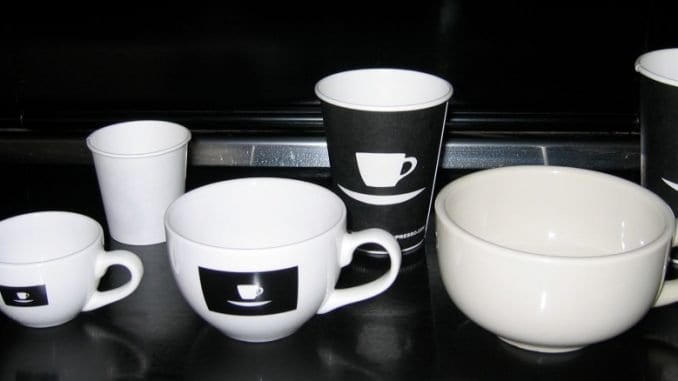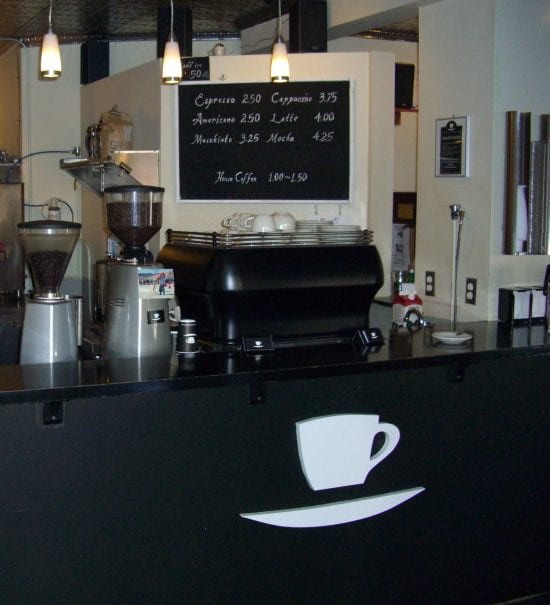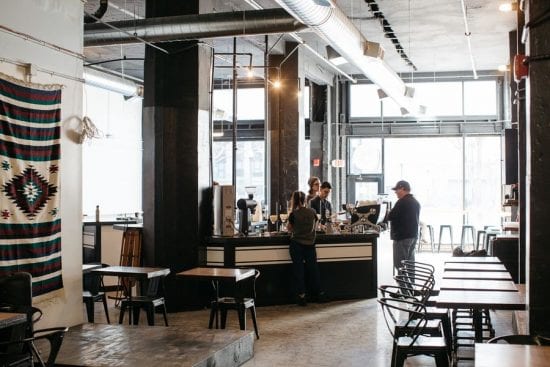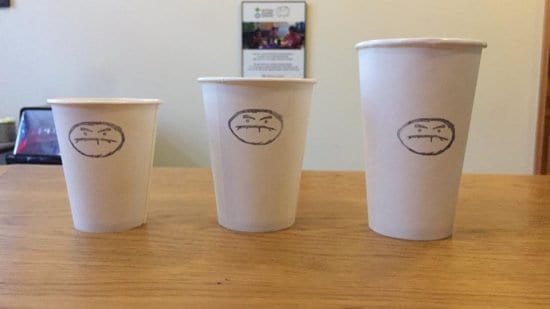
Do you remember when you first started as a barista? Did you have to steam milk for 16, maybe even 20 ounce, drinks? We track the move from bigger to smaller cup sizes and how smaller sizes have helped move coffee into the realm of craft and specialty.
In 2006, Ken Nye shared with Nick Cho and Jay Caragay, hosts of the Portfilter Podcast at the time, that he had eliminated cup sizes. No more would there be a small and large latte—you ordered a latte and it came in a designated cup (a puny 10 ounces at the time). Ken, who owns Ninth Street Espresso in New York, waits silently only to have the hosts respond with only laughter and confusion.
Now, many cafes serve nothing above 12 ounces. Ask for a 16-ounce latte at your local independent coffeeshop and the barista might look at you confused, or even disgusted. But that hasn’t always been the case. A few weeks ago, a reader asked us at Barista Magazine about coffee cup sizes and how smaller sizes have become standard. We didn’t know the answer to this, so we decided to dig around and see what we could find.

Knowing how and why we serve coffee in particular sizes goes back to traditional Italian customs. “If you wanted to be espresso-focused, you had to go smaller,” Ken shares today, almost ten years after he originally decided to do away with cup sizes and options. Traditionally, espresso drinks in Italy are short—no more than six ounces for a cappuccino (and only to be ordered in the morning), and a latte is just some steamed milk with no espresso. In 2006, when Ken launched his new menu, cappuccinos were served in just one size (5.5 ounces for here/eight to go). At the time, the menu was innovative, and perhaps a little bit ostentatious. But there was no mistaking that Ninth Street was a place for serious coffee aficionados to get a well-executed drink. Simply put, to serve espresso with milk in a larger cup took away from the flavor of the espresso. What would be the point of being espresso-focused if you couldn’t even taste it? Patrons looking for flavored drinks in 20 ounce cups could go somewhere else.
Downsizing your drink options today isn’t quite as challenging, and can instill in your patrons a sense of craft and value in the product you’re making. “In 2010 we made the move to offering an eight ounce latte as we progressed in terms of our quality and in wanting to better display our coffees, and for the same reason then got rid of our 20 ounce,” shares Nathan Hamood, President and Director of Roasting Operations for Dessert Oasis Coffee with locations in Rochester and Detroit, Michigan. Nathan, who notes that, “when we first started back in 2009, we actually sold (I’m cringing while I say this) a 20 ounce size, in addition to a 12 and 16 ounce,” but that through downsizing his menu options, customers look to the café as a representative of quality coffee. “In the years since we’ve been far less gentle with our quality pushes as we’ve found that our area is really accepting those craft pushes and is seeking us out for them.”

In most cafes smaller sizes are standard, but there are still vestiges of old, larger drinks in many cafes. “We still have 16 ounce cups for hot, and also 20 for iced,” Liz Dean, Director of Retail for Irving Farm Coffee Roasters, shares. “I tried to get rid of them but all of my managers vetoed because they said the customers in NYC would flip out.” And that seems to be a fear of many café owners—that customers will be upset or even stop going to their cafes when they downsize cup sizes. Ken Nye reported it happening when he eliminated his 16-ounce drink option—it’s something that happens all the time. But Nathan pushed on and used the menu changes to engage with customers. “It was sort of a step by step process to get people comfortable with what we were wanting to do with coffee and to avoid alienating people before even having the chance to convert them. When we found that our market could handle these changes and we could educate people on these things we began making 6 ounce cappuccinos.”
Regardless, the leap from 16 and 20-ounce drinks to 8 and 12 can still be daunting. Many cafes have made a compromise: drip coffee can still be served in larger cups, while espresso drinks are served small. This compromise allows a café to still serve espresso-forward drinks while placating customers who crave a larger cup size and want more coffee (since the quality of the coffee, arguably, will not be affected).

Smaller sizes have been an industry standard for at least most of the 2010’s, but some companies are going backwards. Next time, we make the opposite argument: the case for larger cups.

